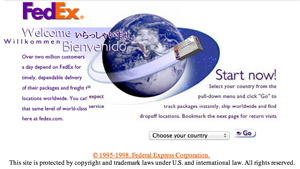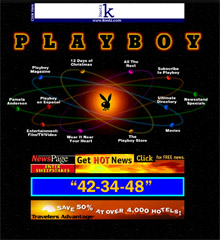
The Web is 25

We’re celebrating! I can remember, sometime in the early Nineties, being irritated when emails and Usenet postings started filling up with these new things called “URLs”, initially-awkward-looking agglomerations of slashes and colons and letters.
I tried to ignore the Web till I couldn’t and then it changed my life and then it changed the world. The change continues. We owe it a lot; what you get out of the Web depends on what you put into it.
Disclosure · I’m hopelessly biased; I built one of the first Web search engines and benefited from one of the first Web IPOs and and consulted for Netscape and was appointed to the W3C TAG and became Director of Web Technologies for Sun Microsystems. Here’s an early-Web war story, from which I quote: “there was a time when being a Web Guy was like being Gandalf the wizard and James Herriot the country vet all rolled into one”.
Inflection points · I’m not going to claim that these are the three most important in the Web’s history. It’s just that when each happened, I felt a palpable shift in the continuum; something switched in and never switched out.

1 · The day when Fedex.com turned on package tracking; the Wayback Machine capture at right suggests that was in February 1998. At that point I was an “Internet consultant”, trying to convince businesspeople that they should take this new “Web” thing seriously, and (to be honest) spinning my wheels a bit, because it was easy to see as a toy. Fedex changed that in an instant: Type in a tracking number, see where your package was, copy the URL out of the browser and email it to your boss. No extra software required, it Just Worked. Total game-changer.

2 · Back in the earliest days, Playboy.com went live; the picture is from December 20, 1996. It’s not that well-known that certain Netscape people reached out to Playboy, convinced them to do this Web thing, and helped them build the site. At one point, their servers were in the same room with pieces of Netscape.com and Yahoo.com; I was in that room and saw them. The historic linkage between the Web and fleshtone-soaked JPEGs is unsubtle; it’s possible that right here is where it started.
3 · The rise of the Mozilla project from the ashes of Netscape, which led (haltingly) to the rise of Firefox; below is a capture from 1998.
Having won the “browser war”, Microsoft was doing its best to ignore the Web, which (to the extent it was visible on a business desktop) was beginning to feel like another Windows application. The rise of end-to-end open-source infrastructure, from browser to back-end, eventually made it clear that the Net belonged to nobody, or rather everybody.
The Future · The Web rules and no serious challengers are in sight. “Wait,” you say, “isn’t the browser imperilled by the rise of mobile apps?” Yes indeed. But those mobile apps are doing all their networking using HTTP, the protocol of the Web, and are addressing all their data using URIs, the name system of the Web. And a whole lot of them are doing their payload rendering with WebViews, which is to say little bits of browser goodness. And anyhow, it’s silly to bet against declarative markup in the long term.
Giving and deserving thanks · We all owe thanks to the Arpanauts and IETF geeks who sketched in the Internet’s protocols and made them work. And to TimBL who put together the simplest hypertext that could possibly work; then instead of sitting back, went out and convinced the world to start using it. Most thanks of all to all the myriad people who’ve made the Web what it is by pouring in their songs and stories and poems and paintings and arguments and desire and despair and cat-blooper videos. The Web’s a container; it’s what it carries that matters.
The job’s not done. We need to defend the Web from those who would eavesdrop on it or censor it or (worst of all) make it end-to-end commercial pablum. The Web is people! Any person can make it better, and everyone who does soon learns that the Web you take is equal to the Web you make.
Comment feed for ongoing:
From: John Cowan (Mar 11 2014, at 21:08)
For me, the inflection point was the day I first saw an URL on a bottle of Snapple.
[link]
From: Brendan (Mar 11 2014, at 22:46)
Further to John's observation about commercialization (Snapple using the Web), hailing from Chicago I'll never forget seeing a full blown URL as an advertisement for the first time (I think it was for Honda or Toyota), showing the world their home page, displayed on a digital billboard near the floor near the Bulls bench during a Chicago Bulls game, in the heyday of Michael Jordan, Scottie Pippen et al.
[link]
From: James Troutman (Mar 12 2014, at 03:21)
1998 seems awfully late for tracking packages on the web. I clearly recall tracking UPS shipments in 1995, but yes, it was one of the ways to get web skeptics on board.
[link]
From: Geoff Arnold (Mar 12 2014, at 03:26)
This strikes me as an odd choice for a 25th birthday. It's the anniversary ofTBL's original proposal, true. But the term World Wide Web didn't come until his joint proposal with Cailleau in 1990, and the web itself didn't go live until August 1991. Of course widespread (non-geek) access wasn't really feasible until the 1992 WinSock API project (of which I was one of four instigators) made it possible to develop generic TCP/IP-based applications - including web browsers - for personal computers.
[link]
From: Mark (Mar 12 2014, at 08:18)
Searching my personal email archive, it appears that the first time I received an email with a URL in it was in 1998. I had asked a friend where to get Playstation 1 mod chips and he sent me the URL of the site to buy them.
The second was an animated e-card that my girlfriend sent me via bluemountain.com, which somehow still exists (the company, not the card -- although I did try the 16-year-old URL just for fun).
The third was amazon.com; I received a virtual gift certificate from my tech-savvy aunt.
The fourth was redmeat.com, which I sent to my friend Michael in an email titled "Best cartoon site on the Net" (yes, I capitalized "Net"). Also still exists.
And that's the 1998 web in a nutshell.
[link]
From: Tom Magliery (Mar 12 2014, at 10:48)
(Comment triggered also by John Cowan's)
In about 1996 some colleagues and I, all employees of NCSA Mosaic (from Illinois) were in California on a business trip. Out at a restaurant, the discussion turned to interesting places we had seen URLs, and we wondered if there would be one on a wine label. We could not manage to make our server understand what a URL was, and finally just told him to bring out every bottle they had from 1996. Sure enough, one of them featured "www.kj.com" (surely also with the http, back then).
[link]
From: Kevin Marks (Mar 12 2014, at 11:48)
Pretty sure Fed-Ex had tracking online before that. I remember writing an article "Expose yourself of the web" in early 1997 that referenced Fed-Ex tracking.
[link]
From: Jonee (Mar 12 2014, at 14:53)
I started building websites in 1995, by 1998 I was working for HappyPuppy.com (sigh), so I think we may be missing a few years from the age.
Still, wonderful to read the thoughts of a pioneer.
Best,
Jonee
[link]
From: John O'Shaughnessy (Mar 14 2014, at 19:25)
I worked at Cray Research in the early 1990's. I remember going in to the office in 1993-1994 on the weekends to read Philip Greenspun's Travels with Samantha. It is still there.
http://philip.greenspun.com/samantha/
I remember being amazed that you could flow text around photos. This was all via NCSA Mosaic. It could have been on an X-terminal.
[link]